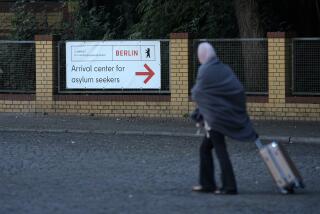Germany’s Schools Fail to Keep Pace as Nation, World Change
- Share via
FRANKFURT, Germany — It sounds like every child’s dream: only 4 1/2 hours of school a day, no attendance taken, a free day if a teacher is sick, no punishment for playing hooky.
But this is no dream, as Germans have suddenly awakened to discover; it’s the sorry state of their schools.
Germany’s education system, like its economy, was once considered the pride of Europe. Worries about the stagnating economy have recently preoccupied Germans, and now they are realizing their schools are also in trouble.
Things have gotten so bad that not only parents are complaining. Even some high school students grumble that it’s hard to take school seriously.
The system reaped praise after World War II for turning out fine shipbuilders and metalworkers. But such vocational training is out of step with the modern and more flexible needs of service-oriented or technical professions.
Also, a 1950s-era assumption that mothers are home in the afternoons to help their children with homework has ceased to hold true as German women enter the work force. So instead of studying after school, many kids are goofing off or getting into trouble.
The real wake-up call came last year when an international test of 15-year-olds ranked Germany 21st out of 32 leading industrialized nations in reading, mathematics and science.
South Korea, Japan and Finland led in all three fields of the Program for International Student Assessment test in 2000, conducted every three years by the Paris-based Organization for Economic Cooperation and Development. U.S. students came in 15th.
Chancellor Gerhard Schroeder’s government has responded by pledging $4 billion over the next five years to create all-day programs for elementary and secondary schools, improve teacher training and revamp classwork to encourage skills development instead of rote learning.
Schroeder, whose wife, Doris Schroeder-Koepf, spends afternoons helping her 11-year-old daughter, Klara, with homework, wants 10,000 more schools to offer extra hours.
Currently 1,800 schools do so -- just 6% of the total.
The Meisterschule in the blue-collar Frankfurt neighborhood of Sindlingen has offered afternoon classes in art, music and sports, as well as tutoring, since the 1970s.
“We felt the children needed more time together with their teachers, more time to really concentrate on learning and encourage their development,” Principal Waltraud Schrader said as she strode around the “all-day” building, a bright red concrete block in the schoolyard that houses a cafeteria, library, music and recreation rooms -- all rarities in German schools.
More typically, German pupils are home by early afternoon -- after three hours of classes in elementary school and less than five hours in middle and high schools.
German pupils are also tracked after fourth grade into secondary schools that determine whether they will learn a trade or vocation or go on to university.
“It is too difficult at the end of fourth grade to determine who should go into which [secondary] school,” said Hans Bruegelmann, an education professor at the University of Siegen.
The reasons for the decline are many, but the situation in Germany was exacerbated, educators say, because it took so long to realize the system was in trouble.
“In countries like Britain or the United States there is a tradition of monitoring education that allows them to see what works and what doesn’t,” said Cordula Artelt, an education expert with the Max Planck Institute in Germany.
“We haven’t done that,” she said. “We have almost no indication of how well the system is working.”
Once in college -- government-funded and free of charge, like lower schools -- students take an average of seven years to earn a degree. Only 32% of them actually do so, well below the average of 48% for industrialized nations.
Germany has relatively few private schools and they are expensive.
Private universities are almost nonexistent.
Particularly disadvantaged are the children of immigrants, who speak little or no German -- a problem highlighted by the PISA test results, which showed that schools with the worst scores had the highest number of immigrant pupils.
But given the chance, Jonas, the son of Moroccan immigrants, has taken it. An avid reader and frequent visitor to the Meisterschule’s library, he uses the after-school program to read more and get a teacher’s help with his homework.
“All-day programs really help kids like him get ahead,” Schrader said.
Huguette Morin-Hauser’s two boys attend Frankfurt’s Lessing High School. They tell a wholly different story.
“Only about a third of all teachers can assert themselves,” says Patrick, her 15-year-old. “So many kids skip school, but nobody cares. It creates a real ‘so what?’ atmosphere.”
Morin-Hauser said her younger son, Pascal, didn’t start school until he was 7. Grading, considered bad for self-esteem, begins only in 3rd grade. There is only one parent-teacher conference a year, and Pascal’s lack of motivation and occasionally aggressive behavior in elementary school went undetected for years, she said.
Ultimately, the problems in Germany’s education system translate into young people poorly prepared for the job market. Meanwhile, companies complain that they can’t find qualified graduates.
Despite more than 11% unemployment, Germany has to attract highly trained immigrant workers to fill an estimated 100,000 high-tech jobs.
Education Minister Edelgard Bulmahn has visited U.S. universities to learn why they are so successful at attracting -- and keeping -- the world’s brightest.
According to the Education Ministry, 14% of German doctoral grads leave for research posts at U.S. universities once they have their degrees.
More to Read
Sign up for Essential California
The most important California stories and recommendations in your inbox every morning.
You may occasionally receive promotional content from the Los Angeles Times.













